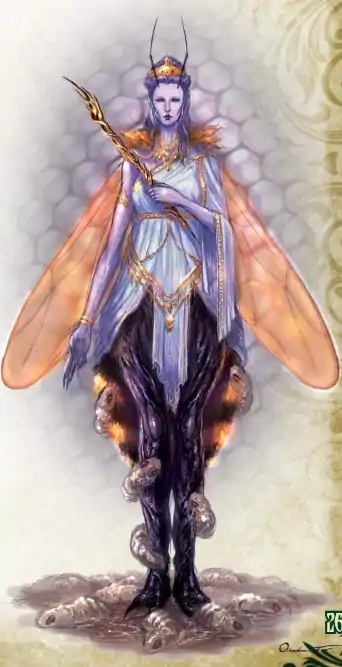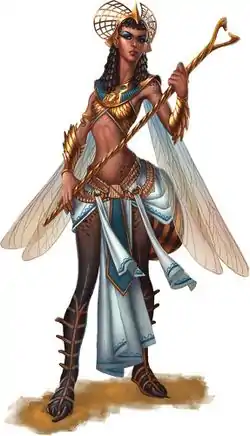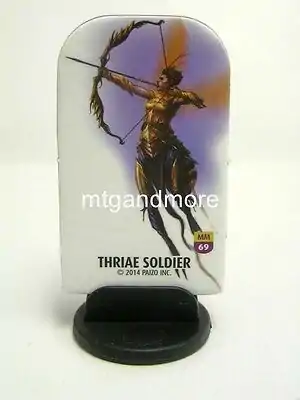Thriae (Beefolk) (5e Creature)
Thriae
Highly spiritual creatures and keepers of the world's greatest secrets, the thriae are a race of female, beelike seers coveted for their powers of divination and prophecy. Roughly humanoid in size and appearance, thriae keep to the outskirts of civilization, tending to their mysterious rituals and maintaining a watchful—if passive—eye over the machinations of nearby societies. While possessing an eerie air of mysticism, thriae are nonetheless startlingly beautiful, their slender bodies giving an unexpected grace to the otherwise unsightly mannerisms of giant bees.
Settlements that find themselves near the hilly homes of thriae hives often send a chosen citizen to visit the creatures, hoping to glean helpful insight from the wise prophetesses regarding the growth of the settlement's crops, the prosperity of its people, or the strength of its warriors. Thriae have little interest in the affairs of most humanoids, but do aid those who come bearing offerings of gold or physically fit male consorts. All thriae are female, and so the queen must breed with humanoid males in order to propagate the colony. If a colony hasn't received an offering of a suitable consort recently, thriae sometimes visit nearby settlements in the hope of garnering young male volunteers to come and live with them for the rest of their lives—living with the thriae exposes chosen males to many of the mysterious race's secrets, so the prophetesses cannot afford to let them leave the thriae's domains once they have entered. The life of male consorts is one of comfort and luxury, however, as they spend their days in a blissful trance brought on by the mind-altering effects of the thriae queen's nourishing honey, a substance called merope. Once they are too old to continue their duties, the males are put in a deep, numbing sleep, whereupon the thriae painlessly devour the consorts' elderly bodies. Thriae generally do not have emotional ties to their humanoid mates, using them for procreation only—exceptions exist, particularly among non-queen thriae, who cannot lay eggs but sometimes choose a willing mate anyway. Only the queen can lay eggs; a typical queen produces 400 to 500 eggs in her lifetime. The life span of a typical thriae who does not die in battle is about 200 years.
Thriae choose particularly spiritual individuals to become seers, members of the colony who perform the rituals that allow them to divine their cryptic prophecies. These seers drink from merope and derive meaning from their spiritual hallucinations, traveling into the forests or mountains to decode various patterns among nature. Thriae hold a particular reverence for the structures and communication patterns of common bees, patterns which they often study intently while undergoing their merope-induced spiritual journeys. The bond thriae have with common bees and giant bees extends beyond this, however, as many powerful thriae possess the ability to call forth such insects when they are in need of aid, such as while protecting their homes. Thriae are extremely territorial, and disrupt their normally stoic behavior to passionately fight off intruders or creatures otherwise imposing upon their domain. Many thriae colonies can trace back their lineages thousands of years, keeping extensive archives hidden within the catacombs of their labyrinthine hives. The hives thriae reside in resemble the beehives of their miniature relatives, but constructed on a much grander fashion and scale. Since thriae fly wherever they go, they tend to build their most important chambers higher up in order to deter bipedal would-be burglars.
Thriae come in various shapes and sizes, their abilities ranging equally in terms of specialization. An individual thriae's occupation within the particular thriae society she is born into is selected by her elders when she reaches adolescence, several months after her development as a larva and then as a pupa. Once her occupation is determined, a young thriae is assigned a "mother," and is trained by this elder to perform her tasks perfectly so as to keep the hive in fully autonomous order. Many thriae never see battle in their lifetimes, instead performing tasks such as recording scriptures derived from seers' verbal prophecies, cultivating the crops and herd animals that thriae use for food, or crafting elaborate crowns, necklaces, and other ornaments unique to thriae and renowned by jewelers the world over. Thriae have a fascination with all kinds of rare metals, and the intricate ways in which they utilize these alloys in building their wares exemplifies the race's passion and ingenuity. They do not regularly trade with outside societies except in times of dire need, such as during a feud or war that cuts off access to needed resources.
Thriae Merope
Merope, the magical honey produced by thriae queens, possesses numerous supernatural properties. Even among thriae, the effects of drinking merope are remarkably diverse. A specific amount of merope for one thriae may put her into a tranquil haze, while the same amount for another could set off a bout of insatiable rage. The effect of merope on a specific type of thriae is marked in a thriae's stat block.
To non-thriae, merope generally has similar effects to strong alcohol. The substance can be addicting to the weak-willed, and those who begin to rely on merope quickly become addicted thralls and servants bound to servitude within a hive. Some thriae claim to have developed merope with the ability to affect non-thriae with more potent effects, but such claims are regarded as something between blasphemy and treason by most thriae hives.
Thriae Queen
Main Article: Thriae Queen (5e Creature)
|
Huge monstrosity (thriae), lawful neutral Armor Class 20 (natural armor)
Saving Throws Dex +6, Wis +12 Alert. The thriae gains a +5 bonus to initiative rolls. She can't be surprised while conscious, and other creatures do not gain advantage on attack rolls against her as a result of being hidden from her. Improved Critical. The thriae's weapon attacks score a critical hit on a die roll of 19 or 20. Innate Spellcasting. The thriae's spellcasting ability is Wisdom (spell save DC 20, +12 to hit with spell attacks). She can innately cast the following spells, requiring no material components: At will: daylight, detect thoughts, protection from poison, scrying, speak with dead Legendary Resistance (3/Day). If the thriae fails a saving throw, she can choose to succeed instead. Magic Resistance. The thriae has advantage on saving throws against spells and other magical effects. Magic Weapons. The thriae's weapon attacks are considered magical. Regeneration. The thriae recovers 10 hit points at the start of her turn if she has at least 1 hit point remaining. Spell Reflection. When a creature targets the thriae with a spell attack and misses, or the thriae succeeds on her saving throw against a spell or other magical effect, the effect is reflected back at the caster as though it originated from the thriae, turning the caster into the target. ACTIONSMultiattack. The thriae makes two attacks: one with her mace and one with her stinger. Mace. Melee Weapon Attack: +13 to hit, reach 10 ft., one target. Hit: 17 (3d6 + 7) bludgeoning damage. Stinger. Melee Weapon Attack: +13 to hit, reach 10 ft., one target. Hit: 20 (3d8 + 7) piercing damage, and the target must make a DC 21 Constitution saving throw. On a failed save, the target's Constitution score is reduced by 1d6, and the target is poisoned and stunned for 1 minute. A creature can repeat the saving throw at the start of each of its turns, and is no longer stunned upon a successful saving throw. Launch Merope (Recharge 5-6). The thriae launches a stream of merope in a 60-foot long, 5-foot wide line from a gland in her lower body. The thriae can control the purity of the merope she launches, which makes it either harm those it touches or heal them. If she chooses to make her merope harmful, all creatures in the area of effect must make a DC 22 Constitution saving throw. On a failed save, a creature takes 54 (12d8) acid damage and is stunned for 1 round. On a successful save, a creature takes half as much damage and isn't stunned. If the queen uses her merope to heal, all creatures in the area of effect recover 27 (6d8) hit points. Spawn Soldiers (3/Day). The thriae summons a large swarm of wasps. This functions as four separate swarms of insects (wasps) that occupy the area within 5 feet of the thriae. These swarms do not harm any thriae. They move with the queen as she moves, and they do not leave her side. The swarms last until they are destroyed or 1 hour passes, at which point the swarms die on their own. REACTIONSBloody Merope. When the thriae falls below half her hit point maximum, the thriae recharges her Launch Merope and uses it. Once the thriae takes this reaction, she can't take it again until she reaches her hit point maximum. LEGENDARY ACTIONSThe thriae queen can take 3 legendary actions, choosing from the options below. Only one legendary action option can be used at a time and only at the end of another creature's turn. The thriae queen regains spent legendary actions at the start of her turn. Command Subjects. The thriae targets up to three creatures in any combination of giant wasps, swarms of insects (wasps), and other thriae that she can see within 60 feet of her. The selected creatures can use their reaction to move up to half their speed and make one weapon attack each. |
The most powerful individual within any given thriae colony, the queen is a divine soothsayer, a provider of life, and a destroyer of those would seek to disrupt the order of the colony. Viewed by her children as a benevolent matriarch rather than a mother, the thriae queen is the only fertile member of the colony, and thus the sole reproducer should the colony's population meet a devastating blow, whether through plague, famine, or war. A queen is revered by soldiers and seers alike, both for her physical might and her divine power, and she exemplifies the very best of thriae society in terms of strength, insight, and magnetism. While a queen is often too busy to entertain guests of a thriae hive, those intruders who do catch a glimpse of her are captured by her beauty and grace, and many would follow her if only to be by her side. But those who are allowed to enjoy the queen's company are few, and those few are carefully selected from among the hive's greatest warriors and priestesses, soldiers and seers whose powers have shown them to be skillful as well as loyal. Most thriae colonies only have one queen, though particularly large or far-reaching hives have been known to have as many as three at any given time. Thriae queens are the ultimate authority within a hive, and make most of the major decisions regarding the colony's growth. Only the wealthiest and most respected outsiders are granted an audience with the ever-busy queen, whose numerous duties around the hive are analogous to those of any other ruler of a small kingdom. They grant only audiences regarding matters of the utmost concern, matters that stimulate the curiosity of a thriae queen and require not merely the cryptic readings of seers but a true divination as only a queen can provide. When not divining or performing governmental tasks, a thriae queen can often be found in her private chamber, where she lies with male consorts, lays eggs, cares for her larvae, and creates the vast stores of merope used every day within the hive. Consorts are chosen carefully, as they are constantly within extremely close proximity to the queen, who is far from vulnerable in her own right but nonetheless often prefers to avoid conflicts with would-be assassins or burglars. A thriae queen lays fertilized eggs in one of the waxy, golden cells of her chamber walls. Thriae eggs go through several stages of growth before becoming fully formed thriae—the longest stage of development is the larval stage, which is a crucial point in determining the formation of a thriae. Most larvae are fed merope while they grow, but in the height of her power, a thriae queen selects a single larva to be her successor, and she feeds that individual a special substance secreted from her merope gland called royal merope. This thick, jellylike substance strengthens the larva and causes it to grow greatly in size, and when it pupates and hatches, it does so as a fully grown thriae queen. The mother queen teaches its successor in the ways of divining as well as ruling a colony. The successor then faces a choice—either remaining in the colony she was born into and furthering the growth of the hive, or setting out on her own to establish an allied colony. If she does the latter, the remaining queen must birth another successor, which is not considered so much a bother as it is an unavoidable circumstance. Queens do not look upon successors who leave as deserting daughters, instead viewing them as future allies for the colony down the road. |
Thriae Larvae
Larvae who are fed regular merope become soldiers, seers, or other contributing members of thriae society. While more susceptible to harm in the larval stage, thriae larvae still pose a threat to unwary intruders who find themselves among the cells of numerous unhatched thriae. Creatures that succeed at a DC 15 Wisdom (Perception) check or Intelligence (Nature) check notice larvae embedded in the hive's waxy walls. Unhatched thriae larvae can detect disturbances outside their cell walls, and burst from the cells in order to prey upon the nutritious intruders. Any creature within 5 feet of a larval cell must make a DC 15 Dexterity saving throw to avoid becoming infested with the larvae. A creature that becomes infested must make a successful DC 15 Constitution saving throw each round to avoid falling asleep (as if affected by a sleep spell) and having their Constitution score reduced by 1d2. A creature whose Constitution score is reduced to 0 in this manner dies. Feeding larvae can be detached from the creature they cling to by cutting them off with a weapon that deals slashing damage (which requires a DC 20 Wisdom (Medicine) check that deals 1d4 slashing damage to the host per larva attached) or by dealing cold damage to the larvae at any time, which also deals half damage to the creature the larvae are covering. Lesser restoration or a similar effect kills any thriae larvae on the host, and restores the host's Constitution score.
Thriae Seer
Main Article: Thriae Seer (5e Creature)
|
Medium humanoid (thriae), lawful neutral Armor Class 14 (16 with shield of faith)
Saving Throws Dexterity +7, Wisdom +7 Magic Resistance. The thriae has advantage on saving throws against spells and other magical effects. Spellcasting. The thriae is a 10th-level spellcaster. Her spellcasting ability is Wisdom (spell save DC 15, +7 to hit with spell attacks). The thriae has the following cleric spells prepared: ACTIONSStinger. Melee Weapon Attack: +5 to hit, reach 5 ft., one creature. Hit: 8 (1d8+4) piercing damage, and the target must make a DC 14 Constitution saving throw. On a failed save, the creature is poisoned for the next minute, and is confused while poisoned in this way, as if affected by a confusion spell. A creature can repeat the saving throw at the end of each of its turns, ending the poison early on a success. Merope Consumption (3/Day). The thriae consumes a dose of merope, which allows her to further tap into her spiritual powers. For the next minute, the thriae gains a +4 bonus to her AC, attack rolls, and damage rolls, and she can't use this action again until its effects have worn off.
|
Sought after for their wisdom and guidance as well as their enchanting beauty, thriae seers are among the most spiritually gifted members of their colony. Their prowess for foretelling the future and deciding upon the soundest courses of action in dire situations earns them respect from other thriae as well as outsiders from other societies, and seers wield their gift with a stoic humbleness. Nonetheless, most seers expect an offering before they will grant an audience a divination. These offerings usually consist of ornate jewelry and sums of gold, though some seers desire the company of humanoid male or female consorts, many of whom gladly oblige the captivating seer with their presence. While their combative abilities mainly comprise their magical powers and they appear at first glance to be thin and frail, seers still possess the trademark strength and resilience of all thriae. Thriae seers spend most of their time meditating in one of the many chambers in the colony's hive dedicated to such activities. Consuming large amounts of their queen's merope to enhance their powers of divination, seers ponder the best solutions to their colony's problems, and often act as a sort of spiritual political council for the queen. If a particularly wealthy group of outsiders has sought the counsel of several thriae seers, this council of prophetesses will combine their powers in order to read a difficult divination. Thriae seers are 6 feet from head to toe and weigh 150 pounds. The thriae seer presented here represents the least of her kind. Many thriae seers take levels of monk or rogue so as to be even more adept at protecting their queen. Thriae sorcerers are also relatively common—such thriae are particularly valued by their hive for their magical abilities. |
Thriae Soldier
Main Article: Thriae Soldier (5e Creature)
|
Medium humanoid (thriae), lawful neutral Armor Class 16 (breastplate)
Saving Throws Dex +5, Wis +3 ACTIONSStinger. Melee Weapon Attack: +5 to hit, reach 5 ft., one creature. Hit: 7 (1d8 + 3) piercing damage, and the target must make a DC 13 Constitution saving throw. On a failed save, the creature is poisoned for 1 minute. At the start of each of the creature's turns, while poisoned in this way, the creature takes 3 (1d6) poison damage, and its Strength score is reduced by 1d2. If this poison reduces a creature's Strength score to 0, the creature is paralyzed until its Strength score is restored. An affected creature can repeat the saving throw at the end of each of its turns, ending the poison early on a success. A lesser restoration spell restores the Strength score of a creature affected by this poison. Longbow. Ranged Weapon Attack: +5 to hit, range 150/600 ft., one target. Hit: 7 (1d8 + 3) piercing damage. Merope Consumption (1/Day). The thriae consumes a dose of merope, which enhances her combat ability. For the next minute, the thriae gains a +2 bonus to her saving throws and attack rolls, and she recovers 3 hit points at the start of each of her turns.
|
The guardians of the thriae colony and its treasures, thriae soldiers make up the backbone of a hive's defenses. Whether patrolling the perimeter of the hive or protecting its queen and seers from attackers, soldiers are a crucial asset ensuring a colony's survival, and so it makes sense that they compose the majority of thriae populations. While not as spiritually powerful as their seer and queen kin, soldiers possess remarkable agility and skill with the bow. Guards remain stationed in pairs outside doors to important areas, such as the meditation chambers of seers and the enormous private quarters of the queen, and when their duties take them outside the walls of the hive, they travel in large convoys. A thriae soldier's stinger carries within it especially potent venom similar to that of giant bees, and the soldier can easily apply this poison to her weapons. While most soldiers carry bows, they are also trained at an early age with a multitude of both melee and ranged weapons, and some prefer the feel of a sword or hammer. Regardless of the type, all thriae weapons and armors are expertly crafted, made of steel and gilded with intricate decorations of gold and amber-hued gems. Thriae soldiers are often talented artisans as well as warriors, and most create their own weapons to bear in combat. Since there are exponentially more soldiers than seers in any given colony, thriae queens ration merope sparingly to soldiers, whose use of it doesn't provoke the divine insight cherished by thriae culture, but rather inspires courage and brute strength on the battlefield. When a thriae soldier consumes merope, her reflexes quicken, her wits sharpen, and she gains a second wind, so most individuals save their rationed doses for times of dire need. When circumstances are especially grim, commanders of thriae militias will order all of their troops to consume their merope at once, giving the company the final burst of strength it needs to turn the tide of battle. Thriae soldiers are heavier-set than most of their slender thriae sisters, and average individuals weigh about 200 pounds and measure around 6 feet from head to toe. |
Back to Main Page → 5e Homebrew → 5e Creatures





